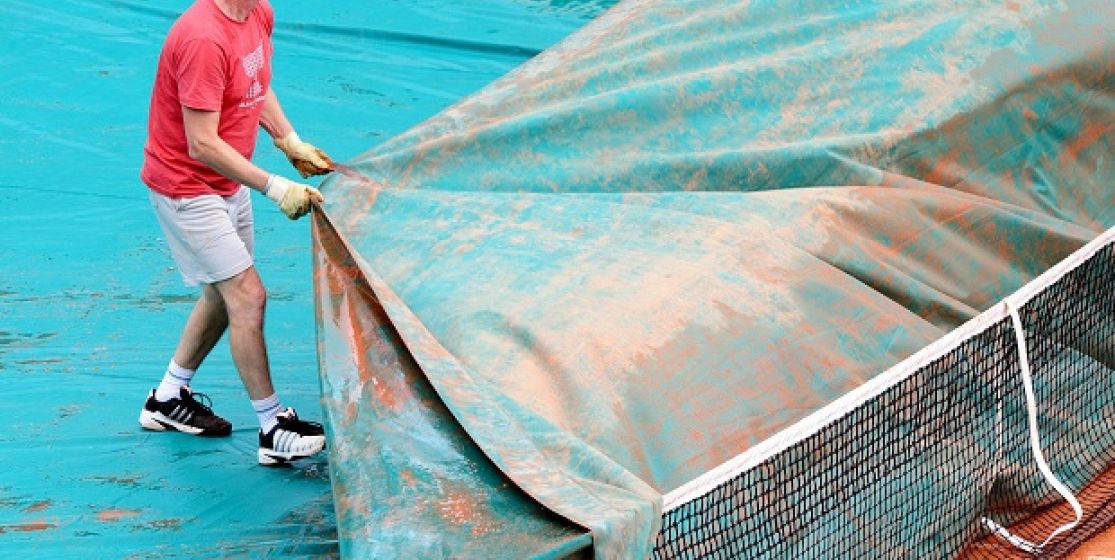After a rain shower, the organizers of the Casablanca tournament have set the court on fire to dry out the clay. A never-seen-before method in Europe. But is it really a bad solution ?
October 15th. Maxime Janvier is easily leading 6-4, 4-2 against Stefanos Tsitsipas on the Casablanca clay when the rain shower comes in. At the worst moment for this Challenger tournament, as the game being played is actually the final. Being used to the sun, the organizers hadn’t planned for the rain to come. And didn’t have any solution to face it. Really ? As it quickly stopped raining, they chose a more than aggressive solution. Spreading alcool on the court and setting it on fire to dry it out.
A few minutes the late, the French player could hit the ball again, to finish off his opponent and win the title (6-4, 6-2). As if nothing had happened.
« The court turned black. »
For obvious reasons, the video has created a buzz on the internet and has been largely commented on the social networks. Without, however, managing to find an answer to the question that everyone has been asking : what on earth were the organizers thinking ? « Independently of all discriminatory words, I would say that it is an « african » way of dealing with the problem », says Jacques Simeon. For the manager of Courts Simeon, a company specialized in the creation and maintenance ou clay courts, which is notably working for Roland-Garros, it’s not a first : « Two or three decades ago, for a Davis Cup match which was being played in Zimbabwe, a clay court had been built with laterite, a red stone of lower quality. After a morning storm, the organizers were stunned to find a swimming pool instead of the court. Without a second thought, they rushed to the airport to get some kerosene and poured it on the whole court. Before setting it on fire. There was lots of smoke, just like a mushroom cloud, and the whole court turned black. »
The fire strategy, despite being rare, is used in case of emergency in certain geographical areas. But if it enables to dry out the clay, and make the court useable again in no time, doesn’t it damage the clay ? « No, it’s not dangerous for the surface, it doesn’t do any damage to it », says, quite unexpectedly, Bruno Slastan, who has been the responsable for the maintenance of the courts at Roland-Garros since 1989, and who has also witnessed similar scenes in Brazil. An opinion shared by Jacques Simeon : « After a harvest, some farmers set their straw on fire, which doesn’t damage their ground. It’s quite the contrary. There, even if the goal is not to grow beetroots, the ground isn’t damaged either. » The only problems seemed to be rather linked to logistics : fire erases the lines on the courts, which have to be drawn again after. It also turns the burnt areas of the court black, so they have to be scratched, and the smell can be quite unpleasant.
Banned in France
Not only is this method described by Jacques Simeon as « resourceful » efficient, but it also seems to have no current match in the tennis world. « Unfortunately, when a court is wet, there is no solution, says Bruno Slastan. The only thing to do is wait for the water to evacuate. » However, some of the tournaments of the Challenger circuit, notably the ones located on the african continent, don’t have the resources to equip themselves with plastic tarps, which are essential in case of rain, to protect the court. Hence the use of fire. « Careful, their courts are not of lesser quality. The problem is that in Casablanca, the sun is always there, so they don’t have tarp covers, says Jacques Simeon. Yet, they have to find a solution in case of a big storm. And setting the court on fire is always better than not playing at all. So let me congratulate the one who took this initiative. At least, the match was played in time. And the umpire didn’t have to tell the crowd : « Go home, the match is canceled. »
Without tarp covers, French tennis would, in fact, be facing some serious issues. As the fire solution is banned. « In Europe, no one is using it, I can assure you that, says the king of Roland-Garros. It’s forbidden by the law. There are safety norms to respect. Today, if someone tried it, he would end up in jail. It’s not a joke. You’ve never seen it at Roland-Garros and you’ll never see it. Never, ever. But after all, if someone saw it and wants to try it somewhere else… » The court manufacturer is even more firm : « It’s absolutely unimaginable in Europe. Forget about it, it’s out of the question. Making a fire on your property is forbidden because of environmental norms. Imagine setting the Central court of Roland Garros on fire ! That wouldn’t look good, would it ? Without mentioning Madame Royal’s reaction. » Thankfully for Maxime Janvier, the French minister of ecology is not the minister of foreign affairs.
By Florian Cadu



.jpg)



